 |
 |
Our enthusiastic and extremely knowledgeable perennials team is here to answer your questions and help you choose the best perennials for your situation. There’s always something in bloom for sun, shade, butterflies, birds or deer resistance as well as a variety of bulbs for your space.
Stroll through our time-tested favorites and introduce yourself to the newest varieties. We garden with perennials too; we love them and it shows!
|
18 found, showing page 1 of 2
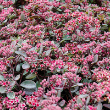
Plant Height: 6 inches
Flower Height: 10 inches
Spacing: 12 inches
Sunlight: full sun, partial shade
Hardiness Zone: 2b
Other Names: Autumn Stonecrop, Showy Stonecrop
Description:
A stunningly attractive perennial for hot, dry locations, featuring succulent bluish-green foliage and dark purple stems all season long, with showy pink flowers in late summer; a compact variety of stonecrop that also boasts excellent fall color
Ornamental Features:
Vera Jameson Stonecrop has masses of beautiful clusters of rose flowers at the ends of the stems from late summer to late fall, which emerge from distinctive coral-pink flower buds, and which are most effective when planted in groupings. The flowers are excellent for cutting. Its attractive succulent round leaves are bluish-green in color. As an added bonus, the foliage turns a gorgeous burgundy in the fall. The deep purple stems are very colorful and add to the overall interest of the plant.
Landscape Attributes:
Vera Jameson Stonecrop is a dense herbaceous perennial with an upright spreading habit of growth. Its medium texture blends into the garden, but can always be balanced by a couple of finer or coarser plants for an effective composition.
This is a relatively low maintenance plant, and is best cleaned up in early spring before it resumes active growth for the season. It is a good choice for attracting bees and butterflies to your yard, but is not particularly attractive to deer who tend to leave it alone in favor of tastier treats. It has no significant negative characteristics.
Vera Jameson Stonecrop is recommended for the following landscape applications:
- Mass Planting
- Rock/Alpine Gardens
- Border Edging
- General Garden Use
- Groundcover
- Container Planting
Planting & Growing:
Vera Jameson Stonecrop will grow to be only 6 inches tall at maturity extending to 10 inches tall with the flowers, with a spread of 15 inches. When grown in masses or used as a bedding plant, individual plants should be spaced approximately 12 inches apart. Its foliage tends to remain low and dense right to the ground. It grows at a fast rate, and under ideal conditions can be expected to live for approximately 15 years. As an herbaceous perennial, this plant will usually die back to the crown each winter, and will regrow from the base each spring. Be careful not to disturb the crown in late winter when it may not be readily seen!
This plant does best in full sun to partial shade. It is very adaptable to both dry and moist growing conditions, but will not tolerate any standing water. It is considered to be drought-tolerant, and thus makes an ideal choice for a low-water garden or xeriscape application. It is not particular as to soil pH, but grows best in poor soils, and is able to handle environmental salt. It is highly tolerant of urban pollution and will even thrive in inner city environments. This particular variety is an interspecific hybrid. It can be propagated by division; however, as a cultivated variety, be aware that it may be subject to certain restrictions or prohibitions on propagation.
Vera Jameson Stonecrop is a fine choice for the garden, but it is also a good selection for planting in outdoor pots and containers. It is often used as a 'filler' in the 'spiller-thriller-filler' container combination, providing a mass of flowers and foliage against which the larger thriller plants stand out. Note that when growing plants in outdoor containers and baskets, they may require more frequent waterings than they would in the yard or garden.
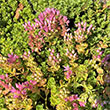
Pink blooms. Green foliage. Evergreen. Moderate foot traffic. USDA 3-8
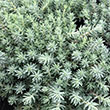
Height: 8 inches
Spacing: 10 inches
Sunlight: full sun, partial shade
Hardiness Zone: 2a
Other Names: Sedum reflexum
Ornamental Features:
Blue Spruce Stonecrop is smothered in stunning gold star-shaped flowers at the ends of the stems from early to mid summer. Its attractive succulent needle-like leaves remain silvery blue in color throughout the season.
Landscape Attributes:
Blue Spruce Stonecrop is a dense herbaceous perennial with a ground-hugging habit of growth. It brings an extremely fine and delicate texture to the garden composition and should be used to full effect.
This plant will require occasional maintenance and upkeep, and is best cleaned up in early spring before it resumes active growth for the season. Deer don't particularly care for this plant and will usually leave it alone in favor of tastier treats. Gardeners should be aware of the following characteristic(s) that may warrant special consideration:
- Spreading
Blue Spruce Stonecrop is recommended for the following landscape applications:
- Mass Planting
- Rock/Alpine Gardens
- Border Edging
- General Garden Use
- Groundcover
- Planting & Growing
Blue Spruce Stonecrop will grow to be about 8 inches tall at maturity, with a spread of 12 inches. When grown in masses or used as a bedding plant, individual plants should be spaced approximately 10 inches apart. Its foliage tends to remain low and dense right to the ground. It grows at a fast rate, and under ideal conditions can be expected to live for approximately 10 years. As an herbaceous perennial, this plant will usually die back to the crown each winter, and will regrow from the base each spring. Be careful not to disturb the crown in late winter when it may not be readily seen!
This plant does best in full sun to partial shade. It prefers dry to average moisture levels with very well-drained soil, and will often die in standing water. It is considered to be drought-tolerant, and thus makes an ideal choice for a low-water garden or xeriscape application. It is not particular as to soil pH, but grows best in poor soils, and is able to handle environmental salt. It is highly tolerant of urban pollution and will even thrive in inner city environments. This species is not originally from North America. It can be propagated by division.
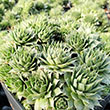
Colorful and cold hardy. One large rosette, called the "hen," sprouts many smaller rosettes around it, called the "chicks." USDA 4-9
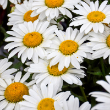
Plant Height: 12 inches
Flower Height: 18 inches
Spacing: 16 inches
Sunlight: full sun, partial shade
Hardiness Zone: 4a
Description:
A delightful variety of the ever-popular shasta daisy known for a high bloom rate; abundant beautiful white blooms with yellow eyes rise above and graciously contrast the deep green foliage; wonderful choice to mass as a garden focal point
Ornamental Features:
Snowcap Shasta Daisy has masses of beautiful white daisy flowers with yellow eyes at the ends of the stems from early to late summer, which are most effective when planted in groupings. The flowers are excellent for cutting. Its serrated narrow leaves remain dark green in color throughout the
season.
Landscape Attributes:
Snowcap Shasta Daisy is an herbaceous perennial with an upright spreading habit of growth. Its medium texture blends into the garden, but can always be balanced by a couple of finer or coarser plants for an effective composition.
This plant will require occasional maintenance and upkeep, and should be cut back in late fall in preparation for winter. It is a good choice for attracting butterflies to your yard. Gardeners should be aware of the following characteristic(s) that may warrant special consideration:
-Insects
Snowcap Shasta Daisy is recommended for the following landscape applications:
- Mass Planting
- Border Edging
- General Garden Use
- Container Planting
Planting & Growing:
Snowcap Shasta Daisy will grow to be about 12 inches tall at maturity extending to 18 inches tall with the flowers, with a spread of 18 inches. When grown in masses or used as a bedding plant, individual plants should be spaced approximately 16 inches apart. It grows at a fast rate, and under ideal conditions can be expected to live for approximately 5 years. As an herbaceous perennial, this plant will usually die back to the crown each winter, and will regrow from the base each spring. Be careful not to disturb the crown in late winter when it may not be readily seen!
This plant does best in full sun to partial shade. It does best in average to evenly moist conditions, but will not tolerate standing water. It is not particular as to soil type or pH. It is highly tolerant of urban pollution and will even thrive in inner city environments. This particular variety is an interspecific hybrid. It can be propagated by division; however, as a cultivated variety, be aware that it may be subject to certain restrictions or prohibitions on propagation.
Snowcap Shasta Daisy is a fine choice for the garden, but it is also a good selection for planting in outdoor pots and containers. It is often used as a 'filler' in the 'spiller-thriller-filler' container combination, providing a mass of flowers against which the larger thriller plants stand out. Note that when growing plants in outdoor containers and baskets, they may require more frequent waterings than they would in the yard or garden.
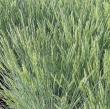
Height: 8 inches
Spread: 12 inches
Sunlight: full sun, partial shade
Hardiness Zone: 2b
Other Names: Festuca ovina var. glauca
Description:
A dwarf ornamental grass featuring bright silver-blue foliage; neat mounds of densely tufted leaves stay blue all season long; tall upright tan plumes sway in the breeze; drought tolerant once established, great for containers, beds and borders
Ornamental Features:
Elijah Blue Fescue is primarily valued in the garden for its interestingly mounded form. Its attractive grassy leaves remain blue in color throughout the year. The tan seed heads are carried on spikes from mid summer to late fall.
Landscape Attributes:
Elijah Blue Fescue is an herbaceous evergreen perennial grass with a mounded form. It brings an extremely fine and delicate texture to the garden composition and should be used to full effect.
This is a relatively low maintenance plant, and is best cleaned up in early spring before it resumes active growth for the season. It has no significant negative characteristics.
Elijah Blue Fescue is recommended for the following landscape applications:
- Rock/Alpine Gardens
- Border Edging
- General Garden Use
- Naturalizing And Woodland Gardens
- Container Planting
Planting & Growing:
Elijah Blue Fescue will grow to be about 8 inches tall at maturity, with a spread of 12 inches. Its foliage tends to remain low and dense right to the ground. It grows at a medium rate, and under ideal conditions can be expected to live for approximately 8 years. As an evegreen perennial, this plant will typically keep its form and foliage year-round.
This plant does best in full sun to partial shade. It prefers to grow in average to dry locations, and dislikes excessive moisture. It is considered to be drought-tolerant, and thus makes an ideal choice for a low-water garden or xeriscape application. It is not particular as to soil type or pH. It is highly tolerant of urban pollution and will even thrive in inner city environments. This is a selected variety of a species not originally from North America. It can be propagated by division; however, as a cultivated variety, be aware that it may be subject to certain restrictions or prohibitions on propagation.
Elijah Blue Fescue is a fine choice for the garden, but it is also a good selection for planting in outdoor pots and containers. It is often used as a 'filler' in the 'spiller-thriller-filler' container combination, providing a canvas of foliage against which the thriller plants stand out. Note that when growing plants in outdoor containers and baskets, they may require more frequent waterings than they would in the yard or garden.
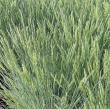
Powder blue foliage. Dense clumping. Semi-evergreen. USDA 4-8
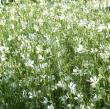
Pure white blooms. Compact. Tolerates poor soils. USDA 5-9
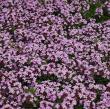
Pink blooms. Fragrant foliage. Evergreen. Moderate foot traffic. USDA 5-8
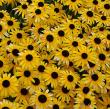
Height: 18 inches
Spacing: 10 inches
Sunlight: full sun
Hardiness Zone: 3a
Other Names: Orange Coneflower, Black Eyed Susan
Ornamental Features:
Viette's Little Suzy Coneflower has masses of beautiful yellow daisy flowers with dark brown eyes at the ends of the stems from mid summer to mid fall, which are most effective when planted in groupings. The flowers are excellent for cutting. Its serrated pointy leaves remain dark green in color throughout the season.
Landscape Attributes:
Viette's Little Suzy Coneflower is an herbaceous perennial with an upright spreading habit of growth. Its medium texture blends into the garden, but can always be balanced by a couple of finer or coarser plants for an effective composition.
This is a relatively low maintenance plant, and should be cut back in late fall in preparation for winter. It is a good choice for attracting butterflies to your yard, but is not particularly attractive to deer who tend to leave it alone in favor of tastier treats. It has no significant negative characteristics.
Viette's Little Suzy Coneflower is recommended for the following landscape applications:
- Mass Planting
- Border Edging
- General Garden Use
- Container Planting
Planting & Growing:
Viette's Little Suzy Coneflower will grow to be about 15 inches tall at maturity, with a spread of 12 inches. When grown in masses or used as a bedding plant, individual plants should be spaced approximately 10 inches apart. It grows at a fast rate, and under ideal conditions can be expected to live for approximately 15 years. As an herbaceous perennial, this plant will usually die back to the crown each winter, and will regrow from the base each spring. Be careful not to disturb the crown in late winter when it may not be readily seen!
This plant should only be grown in full sunlight. It prefers to grow in average to moist conditions, and shouldn't be allowed to dry out. It is not particular as to soil type or pH. It is highly tolerant of urban pollution and will even thrive in inner city environments. This is a selection of a native North American species. It can be propagated by division; however, as a cultivated variety, be aware that it may be subject to certain restrictions or prohibitions on propagation.
Viette's Little Suzy Coneflower is a fine choice for the garden, but it is also a good selection for planting in outdoor pots and containers. It is often used as a 'filler' in the 'spiller-thriller-filler' container combination, providing a mass of flowers against which the larger thriller plants stand out. Note that when growing plants in outdoor containers and baskets, they may require more frequent waterings than they would in the yard or garden.
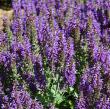
Deep-violet blooms. Dwarf. Fragrant foliage. Upright. Clumping. USDA 4-8
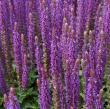
Violet blooms. Long blooming. Fragrant foliage. Compact. USDA 4-8
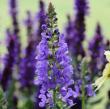
Blue flower spikes. Grey-green foliage. Clumping. USDA 4-9
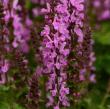
Large deep rose flower spikes. Clumping-grey green foliage. USDA 4-9
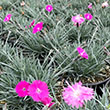
Fragrant pink blooms. Tufted, Mounded habit. USDA: 3-8
18 found, showing page 1 of 2






